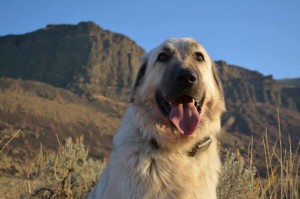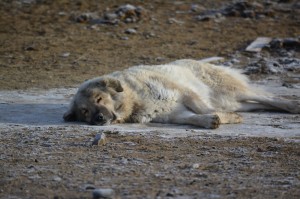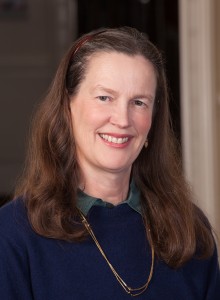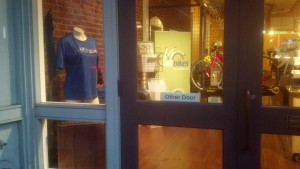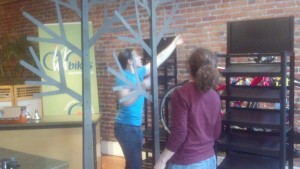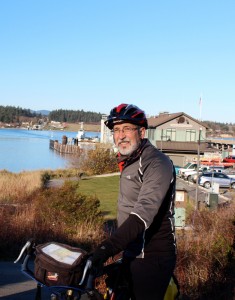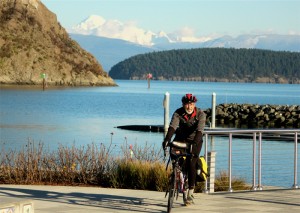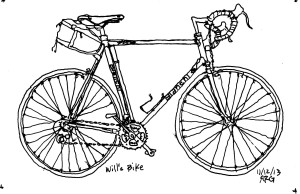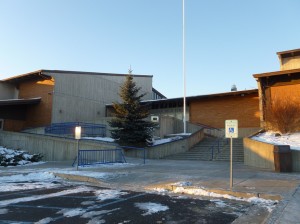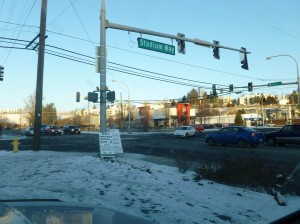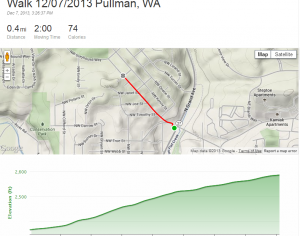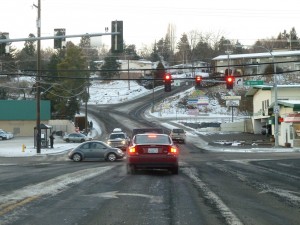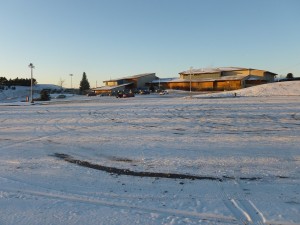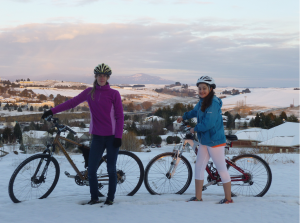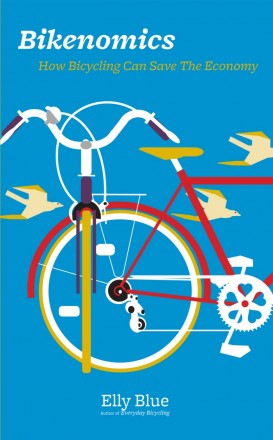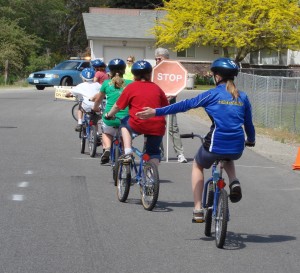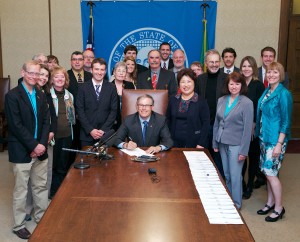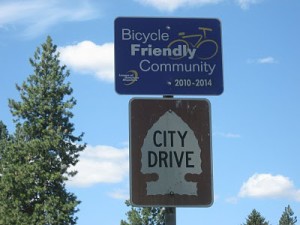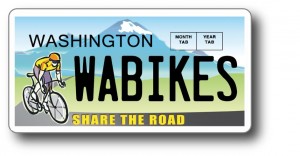Everyone loves a Top 10 list. We could have titled this the Top 10 Books about Bicycling. But only 10? That’s just crazy. And the top 10 best bike books for someone who trains and races competitively is a different list than the top 10 bicycle books of someone who packs panniers for every bike-touring vacation, someone who has recently started running errands by bike and is looking for practical answers on questions about what to wear and how to haul groceries, or someone who loves a deep dive into public policy, public health, or the nuances of traffic calming and streetscape design.
We’ve rounded up a sampling to get your gears turning and hope you’ll add your own recommendations in the comments. Three ways to find them:
- We’ll be carrying some of these in our Pioneer Square storefront, so if you’re near there stop in to see what we have.
- We always encourage you to support your local bookstores–especially the ones that have bike racks! (Any time you spend money at a business because they’ve demonstrated they welcome biking customers, please be a messenger and tell them they got your business because they’re bike-friendly.)
- You can purchase online and support our advocacy by starting at smile.amazon.com and selecting “Bicycle Alliance of Washington” as your charity of choice (we’re working on getting our name change to take effect there). When you do that, Amazon will donate 0.5% of eligible purchases to us.
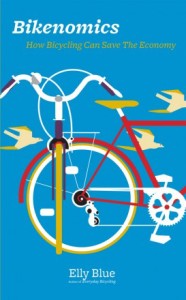 A round-up of a few books to get you thinking and get you rolling:
A round-up of a few books to get you thinking and get you rolling:
- Bikenomics, by Elly Blue: You’ll be quoting this one over the dinner table, to your legislator or Member of Congress, and at the local Chamber of Commerce meeting. Read the review of Bikenomics by our own Josh Miller.
- Gold, by Chris Cleave. This novel of two fictional women track racers vying for a spot on the British Olympics team gives you a taste of what it’s like to train obsessively, how it takes over your life, and the sacrifices it takes to compete at that level.
- Big Brother, by Lionel Shriver. This novel isn’t “about” bicycling per se but if you are (or are partnered with) one of those people who accounts for every calorie consumed, you may have more than one “Yes! Exactly!” moment as you read–or you might gain a little understanding of the occasional sidelong look you get from a partner. It’s also a powerful commentary on the American obsession with body weight.
- Free Country: A Penniless Adventure the Length of Britain, by George Mahood. George and his buddy Ben start out clad only in Union Jack boxer shorts (for the barest modicum of decency) at Land’s End, Britain, determined to travel 1,000 miles to the tip of Scotland by bicycle, relying only on the generosity of strangers to give them everything they need along the way–starting with clothing and shoes. Be prepared to laugh out loud.
- Pedal Power: The Quiet Rise of the Bicycle in American Politics, by J. Harry Wray. This bicycling political scientist’s take on the place of the bicycle in U.S. politics is a great gift for your wonky friends and short enough to be a fast read, not a weighty academic tome.
- Pedaling Revolution: How Cyclists Are Changing American Cities, by Jeff Mapes. Outlines the history behind facets of bike culture such as Davis’s bicycle-friendly design (and the challenge to keeping it that way) and the Naked Bike Ride in the Fremont neighborhood of Seattle, along with the growth of bike advocacy on the streets and in the marble halls of your state legislature and Congress.
- Completing Our Streets, by Barbara McCann. Dedicated “To the memory of Susie Stephens, who planted a seed”–one of our first executive directors who went on to head the Thunderhead Alliance, now the Alliance for Biking and Walking. How can we connect vision to implementation? More importantly, how can we create a shared sense of stewardship and an understanding that streets are for all people, not just those in cars?
- Wheels of Change: How Women Rode the Bicycle to Freedom, by Sue Macy. As Susan B. Anthony famously said, “Let me tell you what I think of bicycling. I think it has done more to emancipate women than anything else in the world. It gives women a feeling of freedom and self-reliance. I stand and rejoice every time I see a woman ride by on a wheel…the picture of free, untrammeled womanhood.”
- Women on Wheels, by April Streeter. This practical guide to city riding rounds up practical advice along with a vision for the future of riding and some inspiring mini-profiles.
 Changing Gears: A Family Odyssey to the End of the World, by Nancy Sathre-Vogel. The Vogel family from Boise, Idaho, set off to bicycle from Alaska to Argentina, following an earlier adventure in which they rode 9,300 miles through the United States and Mexico. If you’ve ever hesitated to take something on because it felt like too big a challenge, this book is sure to inspire and motivate.
Changing Gears: A Family Odyssey to the End of the World, by Nancy Sathre-Vogel. The Vogel family from Boise, Idaho, set off to bicycle from Alaska to Argentina, following an earlier adventure in which they rode 9,300 miles through the United States and Mexico. If you’ve ever hesitated to take something on because it felt like too big a challenge, this book is sure to inspire and motivate.- Around the World on a Bicycle, Vol. I (from San Francisco to Yokohama) and Vol. II (from Yokohama to Teheran), by Thomas Stevens. Available as a free e-book, this work from 1894 is amazing enough to begin with–then you realize that when he refers to his “ordinary” he means he’s riding on a penny-farthing bicycle (or carrying it across a stretch too rocky to ride). Across deserts and over mountains, carrying the money needs in whatever heavy local currency is required, and speaking none of the languages of the countries through which he passes, he makes an amazing trek. You’ll never complain about your travel hardships again.
- Around the World on Two Wheels: Annie Londonderry’s Extraordinary Ride, by Peter Zheutlin. If you ever wondered where the sport of bicycling got the habit of placing sponsor logos all over its clothing, look no further. Jewish immigrant mother Annie Kopchovsky became Annie Londonderry when the Londonderry Lithia Spring Water Company agreed to sponsor her trip around the world.
- The Lost Cyclist: The Epic Tale of an American Adventurer and His Mysterious Disappearance, by David Herlihy. Another around-the-world adventure, this one ending in murder and mystery rather than a triumphant homecoming.
- The Rider, by Tim Krabbe, turns up on every list of bicycling books as a classic. Buy it for the racer in your life–read it to understand him/her, at least a little.
- Cyclopedia: A Century of Iconic Bicycle Design, by Michael Embacher. Total eye candy! Gorgeous coffee-table book.
We also must point you to two amazing lists compiled by member and former staffer Kent Peterson, who works at the Bicycle Center of Issaquah and writes both Kent’s Bike Blog and Kent’s Book Blog:
If you’re not out riding, these lists should give you plenty of reading to do by a cozy fire or on a bus ride. Add your favorites in the comments below, and if you’d like to write a book review for our blog, contact Louise McGrody.

